The Theory of Factor Proportions Lecture 5

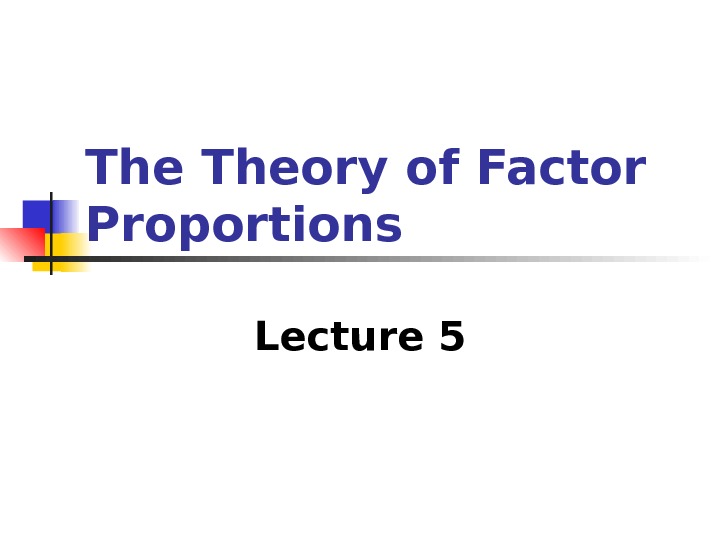






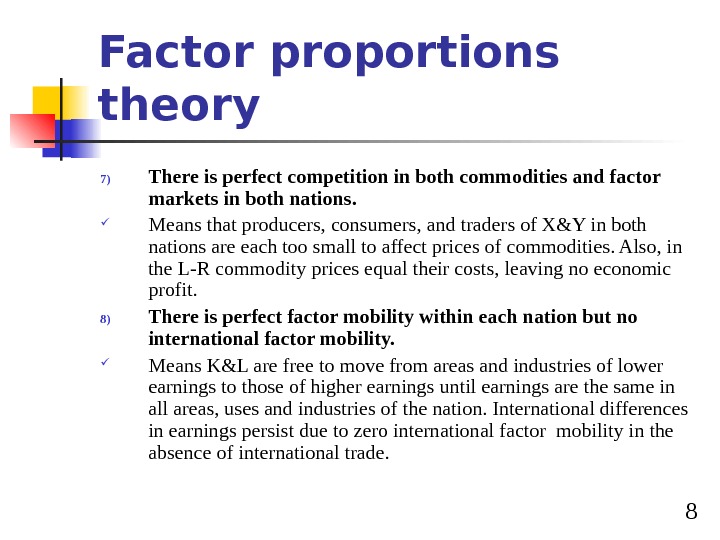


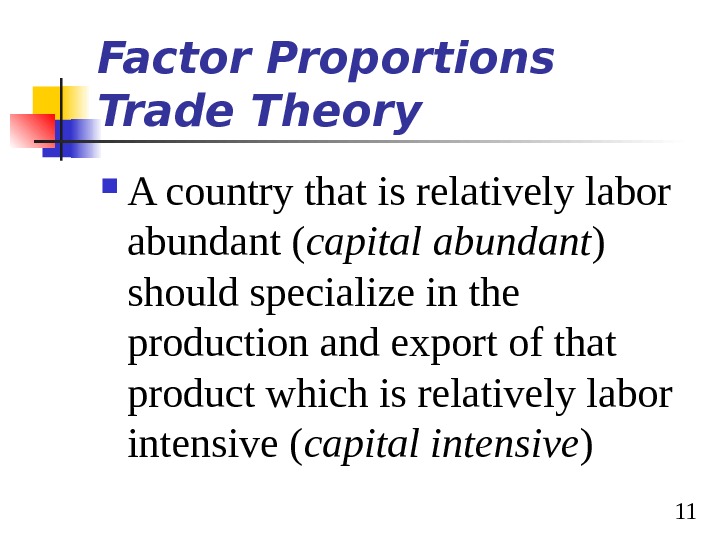






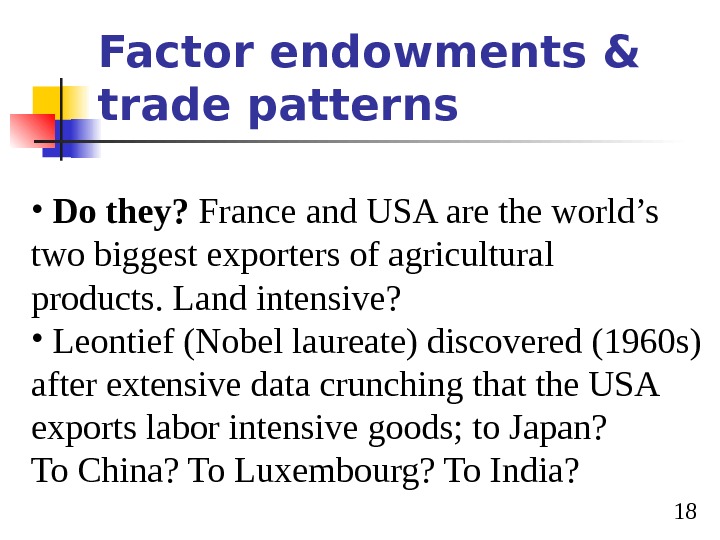

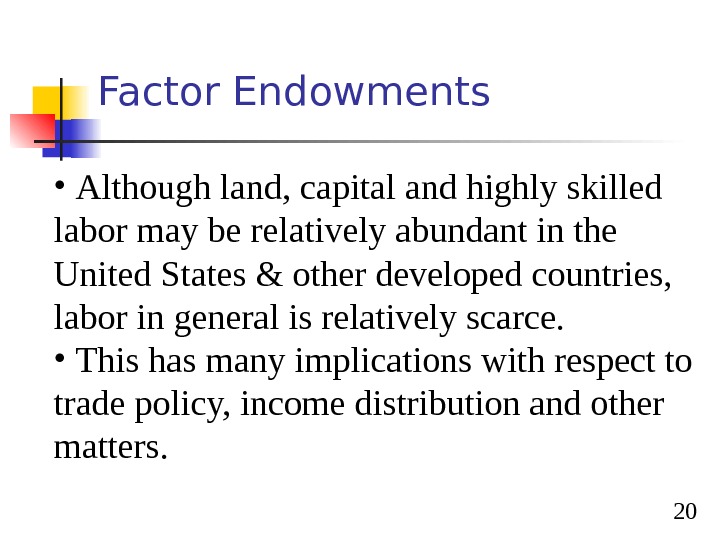



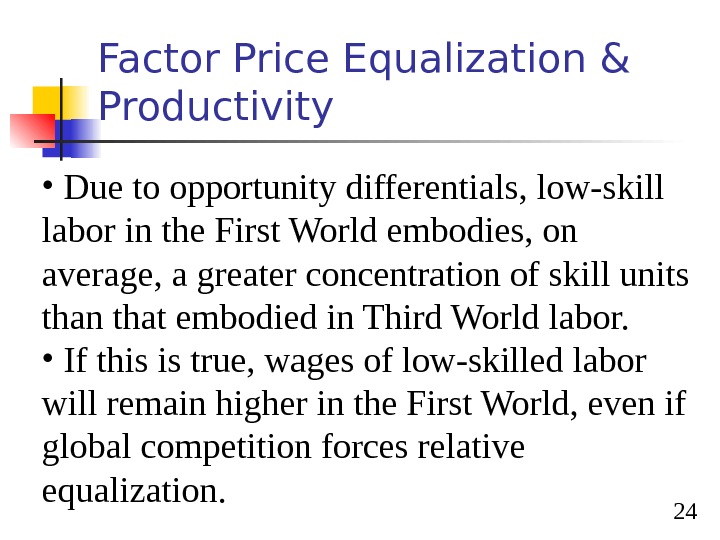






class_th_of_int_trade_-_lecture_5.ppt
- Размер: 138.5 Кб
- Количество слайдов: 30
Описание презентации The Theory of Factor Proportions Lecture 5 по слайдам
 The Theory of Factor Proportions Lecture
The Theory of Factor Proportions Lecture
 2 Lecture 5 Evolution of Trade Theories Mercantilism Absolute Advantage Comparative Advantage Factor proportion Trade International Product Cycle New Trade Theory National Competitive Advantage
2 Lecture 5 Evolution of Trade Theories Mercantilism Absolute Advantage Comparative Advantage Factor proportion Trade International Product Cycle New Trade Theory National Competitive Advantage
 3 Factor proportions theory Heckscher (1919) — Olin (1933) Theory Export goods that intensively use factor endowments which are locally abundant Corollary: import goods made from locally scarce factors Note: Factor endowments can be impacted by government policy — minimum wage Patterns of trade are determined by differences in factor endowments — not productivity Remember, focus on relative advantage, not absolute advantage
3 Factor proportions theory Heckscher (1919) — Olin (1933) Theory Export goods that intensively use factor endowments which are locally abundant Corollary: import goods made from locally scarce factors Note: Factor endowments can be impacted by government policy — minimum wage Patterns of trade are determined by differences in factor endowments — not productivity Remember, focus on relative advantage, not absolute advantage
 4 Factor proportions theory … trade theory holding that countries produce and export those goods that require resources (factors) that are abundant (and thus cheapest) and import those goods that require resources that are in short supply Example: Australia – lot of land a small population (relative to its size) So what should it export and import?
4 Factor proportions theory … trade theory holding that countries produce and export those goods that require resources (factors) that are abundant (and thus cheapest) and import those goods that require resources that are in short supply Example: Australia – lot of land a small population (relative to its size) So what should it export and import?
 5 Factor Proportions Trade Theory Considers Two Factors of Production Labor Capital
5 Factor Proportions Trade Theory Considers Two Factors of Production Labor Capital
 6 Factor proportions theory The Assumptions 1) There are two nations (1&2), two commodities (X&Y), two factors of production (labor & capital). Used to illustrate theory in a two-dimensional figure. 2) Both nations use the same technology in production. Means both nations have access to and use the same general production techniques. 3) Commodity X is labor intensive and Y is capital intensive in both nations. Means the labor-capital ratio (L/K) is higher for X than Y in both nations at the same relative factor prices.
6 Factor proportions theory The Assumptions 1) There are two nations (1&2), two commodities (X&Y), two factors of production (labor & capital). Used to illustrate theory in a two-dimensional figure. 2) Both nations use the same technology in production. Means both nations have access to and use the same general production techniques. 3) Commodity X is labor intensive and Y is capital intensive in both nations. Means the labor-capital ratio (L/K) is higher for X than Y in both nations at the same relative factor prices.
 7 Factor proportions theory 4) Both commodities are produced under constant returns to scale in both nations. Means that increasing the amount of L and K will increase output in the same proportion 5) There is incomplete specialization in production in both nations. Means that even with free trade both nations continue to produce both commodities. This implies neither nation is very small. 6) Tastes are equal in both nations. Means demand preferences are identical in both nations. When relative prices are equal in the two nations, both consume X&Y in the same proportion.
7 Factor proportions theory 4) Both commodities are produced under constant returns to scale in both nations. Means that increasing the amount of L and K will increase output in the same proportion 5) There is incomplete specialization in production in both nations. Means that even with free trade both nations continue to produce both commodities. This implies neither nation is very small. 6) Tastes are equal in both nations. Means demand preferences are identical in both nations. When relative prices are equal in the two nations, both consume X&Y in the same proportion.
 8 Factor proportions theory 7) There is perfect competition in both commodities and factor markets in both nations. Means that producers, consumers, and traders of X&Y in both nations are each too small to affect prices of commodities. Also, in the L-R commodity prices equal their costs, leaving no economic profit. 8) There is perfect factor mobility within each nation but no international factor mobility. Means K&L are free to move from areas and industries of lower earnings to those of higher earnings until earnings are the same in all areas, uses and industries of the nation. International differences in earnings persist due to zero international factor mobility in the absence of international trade.
8 Factor proportions theory 7) There is perfect competition in both commodities and factor markets in both nations. Means that producers, consumers, and traders of X&Y in both nations are each too small to affect prices of commodities. Also, in the L-R commodity prices equal their costs, leaving no economic profit. 8) There is perfect factor mobility within each nation but no international factor mobility. Means K&L are free to move from areas and industries of lower earnings to those of higher earnings until earnings are the same in all areas, uses and industries of the nation. International differences in earnings persist due to zero international factor mobility in the absence of international trade.
 9 Factor proportions theory 9) There are no transportation costs, tariffs, or other obstructions to the free flow of international trade. Means specialization in production proceeds until relative (and absolute) commodity prices are the same in both nations with trade. If transportation costs and tariffs were allowed, specialization would proceed only until prices differed by no more than the costs and tariffs on each until of the commodity traded.
9 Factor proportions theory 9) There are no transportation costs, tariffs, or other obstructions to the free flow of international trade. Means specialization in production proceeds until relative (and absolute) commodity prices are the same in both nations with trade. If transportation costs and tariffs were allowed, specialization would proceed only until prices differed by no more than the costs and tariffs on each until of the commodity traded.
 10 Factor proportions theory 10) All resources are fully employed in both nations. Means there are no unemployed resources in either nation. 11) International trade between the two nations is balanced. Means that the total value of each nation’s exports equals the total value of the nation’s imports.
10 Factor proportions theory 10) All resources are fully employed in both nations. Means there are no unemployed resources in either nation. 11) International trade between the two nations is balanced. Means that the total value of each nation’s exports equals the total value of the nation’s imports.
 11 Factor Proportions Trade Theory A country that is relatively labor abundant ( capital abundant ) should specialize in the production and export of that product which is relatively labor intensive ( capital intensive )
11 Factor Proportions Trade Theory A country that is relatively labor abundant ( capital abundant ) should specialize in the production and export of that product which is relatively labor intensive ( capital intensive )
 12 The Theory Contains Four Core Propositions Factor endowments and trade patterns Factor price equalization Distribution of income Factor growth and output patterns
12 The Theory Contains Four Core Propositions Factor endowments and trade patterns Factor price equalization Distribution of income Factor growth and output patterns
 13 The Factor-Proportions Theory EXAMPLE: U. S. (capital abundant) has comparative advantage in the production of machines (capital intensive). India (labor abundant) has comparative advantage in production of cloth (labor intensive).
13 The Factor-Proportions Theory EXAMPLE: U. S. (capital abundant) has comparative advantage in the production of machines (capital intensive). India (labor abundant) has comparative advantage in production of cloth (labor intensive).
 14 The Factor-Proportions Theory Factor-proportions theorem A country will have a comparative advantage (disadvantage) and export (import) goods whose production intensively uses its relatively abundant (scarce) factor of production.
14 The Factor-Proportions Theory Factor-proportions theorem A country will have a comparative advantage (disadvantage) and export (import) goods whose production intensively uses its relatively abundant (scarce) factor of production.
 15 The Factor-Proportions Theory The U. S. imports goods from countries where labor in the abundant factor. The U. S. exports goods that are capital intensive. Gains from trade are realized when a country exports goods based on its comparative advantage and imports goods based on comparative disadvantage.
15 The Factor-Proportions Theory The U. S. imports goods from countries where labor in the abundant factor. The U. S. exports goods that are capital intensive. Gains from trade are realized when a country exports goods based on its comparative advantage and imports goods based on comparative disadvantage.
 16 Factor endowments and trade patterns Natural resource version: • USA is relatively well endowed with land. Therefore USA exports farm (land-intensive) products. Singapore is relatively well endowed with marine traffic locational resources. Therefore, Singapore exports shipping, marine insurance, ship repair plus many derivative services.
16 Factor endowments and trade patterns Natural resource version: • USA is relatively well endowed with land. Therefore USA exports farm (land-intensive) products. Singapore is relatively well endowed with marine traffic locational resources. Therefore, Singapore exports shipping, marine insurance, ship repair plus many derivative services.
 17 Factor endowments & trade patterns Developed resource version: • Japan, USA, France & Germany are relatively well endowed, after histories of much investment, with non-human productive resources or capital. • Therefore, they export capital-intensive manufactured goods.
17 Factor endowments & trade patterns Developed resource version: • Japan, USA, France & Germany are relatively well endowed, after histories of much investment, with non-human productive resources or capital. • Therefore, they export capital-intensive manufactured goods.
 18 Factor endowments & trade patterns • Do they? France and USA are the world’s two biggest exporters of agricultural products. Land intensive? • Leontief (Nobel laureate) discovered (1960 s) after extensive data crunching that the USA exports labor intensive goods; to Japan? To China? To Luxembourg? To India?
18 Factor endowments & trade patterns • Do they? France and USA are the world’s two biggest exporters of agricultural products. Land intensive? • Leontief (Nobel laureate) discovered (1960 s) after extensive data crunching that the USA exports labor intensive goods; to Japan? To China? To Luxembourg? To India?
 19 Factor endowments & trade patterns Try to explain that one. • Maybe US labor is (was) human capital intensive. US endowment of capital intensive labor is (was) relatively large by international standards. • Hence, labor intensive exports were really human capital intensive. Try that one on the shop floor at Toyota City!
19 Factor endowments & trade patterns Try to explain that one. • Maybe US labor is (was) human capital intensive. US endowment of capital intensive labor is (was) relatively large by international standards. • Hence, labor intensive exports were really human capital intensive. Try that one on the shop floor at Toyota City!
 20 Factor Endowments • Although land, capital and highly skilled labor may be relatively abundant in the United States & other developed countries, labor in general is relatively scarce. • This has many implications with respect to trade policy, income distribution and other matters.
20 Factor Endowments • Although land, capital and highly skilled labor may be relatively abundant in the United States & other developed countries, labor in general is relatively scarce. • This has many implications with respect to trade policy, income distribution and other matters.
 21 Factor price equalization Labor: Through intense global competition, wages and the return to capital tend to equalize across trading nations. Is this true? Are your wages determined in Bangladesh? Are low-skilled US workers vulnerable? Many who were on the streets of Seattle & Honolulu think so.
21 Factor price equalization Labor: Through intense global competition, wages and the return to capital tend to equalize across trading nations. Is this true? Are your wages determined in Bangladesh? Are low-skilled US workers vulnerable? Many who were on the streets of Seattle & Honolulu think so.
 22 Factor Price Equalization & Productivity A useful abstraction: visualize a worker as an embodiment of natural and acquired skills or sources of productivity. The skills are heterogeneous; some are highly competitive internationally, others are company or geographically specific. • Globalization transforms the specific into global, but the transformation is incomplete.
22 Factor Price Equalization & Productivity A useful abstraction: visualize a worker as an embodiment of natural and acquired skills or sources of productivity. The skills are heterogeneous; some are highly competitive internationally, others are company or geographically specific. • Globalization transforms the specific into global, but the transformation is incomplete.
 23 Factor Price Equalization & Productivity • High tech skills tend to be global and to correlate with mobility. • Medium and low tech skills tend to be more local and less mobile. • However, a major exception may be many low tech skills in the First World which are highly substitutable for skills that exist widely in the Third World.
23 Factor Price Equalization & Productivity • High tech skills tend to be global and to correlate with mobility. • Medium and low tech skills tend to be more local and less mobile. • However, a major exception may be many low tech skills in the First World which are highly substitutable for skills that exist widely in the Third World.
 24 Factor Price Equalization & Productivity • Due to opportunity differentials, low-skill labor in the First World embodies, on average, a greater concentration of skill units than that embodied in Third World labor. • If this is true, wages of low-skilled labor will remain higher in the First World, even if global competition forces relative equalization.
24 Factor Price Equalization & Productivity • Due to opportunity differentials, low-skill labor in the First World embodies, on average, a greater concentration of skill units than that embodied in Third World labor. • If this is true, wages of low-skilled labor will remain higher in the First World, even if global competition forces relative equalization.
 25 Factor price equalization Capital: Heavy investment in a country, whether by its own residents or through foreign direct investment (FDI) leads to falling returns. Resulting excess capacity in Asian countries caused falling returns & inability to pay off loans. Asia ceased to be a better investment than developed countries.
25 Factor price equalization Capital: Heavy investment in a country, whether by its own residents or through foreign direct investment (FDI) leads to falling returns. Resulting excess capacity in Asian countries caused falling returns & inability to pay off loans. Asia ceased to be a better investment than developed countries.
 26 Trade & income distribution Free trade: Land is abundant in USA, scarce in JPN. Free trade enables USA to share its land globally, in an environment in which land is not so abundant. Hence, US farm income rises. However, US abundance swamps JPN’s scarcity causing JPN’s farm income to fall.
26 Trade & income distribution Free trade: Land is abundant in USA, scarce in JPN. Free trade enables USA to share its land globally, in an environment in which land is not so abundant. Hence, US farm income rises. However, US abundance swamps JPN’s scarcity causing JPN’s farm income to fall.
 27 Trade & income distribution Protection: Protection of JPN’s agricultural sector creates a local monopoly, free of USA’s abundant competition and raises JPN’s farm income (lowers USA’s income). Of course, JPN’s consumers pay more. Farmers and related industries win; consumers & others lose.
27 Trade & income distribution Protection: Protection of JPN’s agricultural sector creates a local monopoly, free of USA’s abundant competition and raises JPN’s farm income (lowers USA’s income). Of course, JPN’s consumers pay more. Farmers and related industries win; consumers & others lose.
 28 Trade & income distribution Industrial products: JPN’s automobiles & consumer electronic products and USA’s software, hardware & entertainment output are produced by industries relatively well endowed with key inputs. Owners of these key inputs profit from globalization if exporters, but lose if importers.
28 Trade & income distribution Industrial products: JPN’s automobiles & consumer electronic products and USA’s software, hardware & entertainment output are produced by industries relatively well endowed with key inputs. Owners of these key inputs profit from globalization if exporters, but lose if importers.
 29 Factor growth & output The down side: In a small country, world goods prices are set by large, global markets. Hence, if, for example, population (labor force) rises, labor-intensive industries will grow and capital-intensive industries will shrink.
29 Factor growth & output The down side: In a small country, world goods prices are set by large, global markets. Hence, if, for example, population (labor force) rises, labor-intensive industries will grow and capital-intensive industries will shrink.
 30 Factor growth & output The up side: However, if the country succeeds in developing its physical & human capital stocks, capital and high-skill labor- intensive industries will grow and low- skill labor industries will shrink. This sounds rather like Japan, Korea, Singapore and other countries in the early stages of their development.
30 Factor growth & output The up side: However, if the country succeeds in developing its physical & human capital stocks, capital and high-skill labor- intensive industries will grow and low- skill labor industries will shrink. This sounds rather like Japan, Korea, Singapore and other countries in the early stages of their development.

